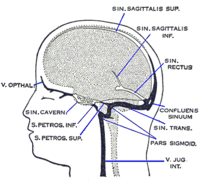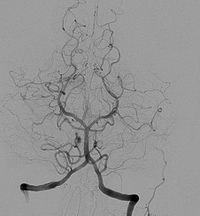
Carotid cavernous fistula secondary to ruptured carotid cavernous aneurysm causing orbital compartment syndrome
Sign Up to like & getrecommendations! Published in 2022 at "American Journal of Ophthalmology Case Reports"
DOI: 10.1016/j.ajoc.2022.101310
Abstract: Purpose To report the rare presentation of orbital compartment syndrome secondary to formation of carotid cavernous fistula in the absence of trauma or surgery and demonstrate the role of emergent canthotomy/cantholysis as a vision saving… read more here.
Keywords: compartment syndrome; orbital compartment; cavernous fistula; carotid cavernous ... See more keywords

Carotid-cavernous fistula after transsphenoidal surgery: A rare but challenging complication.
Sign Up to like & getrecommendations! Published in 2019 at "World neurosurgery"
DOI: 10.1016/j.wneu.2019.10.194
Abstract: BACKGROUND Carotid-cavernous fistula (CCF) is a rare complication after trans-sphenoidal surgery. METHODS The aim of this article is to report a case of CCF after the endoscopic resection of a growth hormone (GH) secreting pituitary… read more here.
Keywords: surgery; cavernous fistula; complication; trans sphenoidal ... See more keywords

Percutaneous transorbital embolization of a carotid cavernous fistula
Sign Up to like & getrecommendations! Published in 2019 at "Baylor University Medical Center Proceedings"
DOI: 10.1080/08998280.2019.1596502
Abstract: Abstract This case report highlights utilization of image-guided, percutaneous transorbital direct cavernous sinus puncture to embolize an anteriorly draining carotid cavernous fistula (CCF) when conventional transarterial and transvenous approaches were not feasible. An 86-year-old man… read more here.
Keywords: percutaneous transorbital; cavernous fistula; carotid cavernous; transorbital embolization ... See more keywords

Hemicranial postural headache as a first symptom of a spontaneous carotid cavernous fistula: A case report
Sign Up to like & getrecommendations! Published in 2022 at "Medicine"
DOI: 10.1097/md.0000000000031088
Abstract: Rationale: Spontaneous carotid cavernous fistula (CCF) is rare, and the expression of headache caused by it can be variable. Patient concerns: A case of a man hospitalized for high-intensity hemicranial headache which was aggravated by… read more here.
Keywords: carotid cavernous; headache; spontaneous carotid; postural headache ... See more keywords

Aspiration catheter failure leading to carotid-cavernous fistula during stroke thrombectomy
Sign Up to like & getrecommendations! Published in 2020 at "BMJ Case Reports"
DOI: 10.1136/bcr-2020-017054
Abstract: Endovascular thrombectomy in acute ischaemic stroke commonly uses aspiration catheters, either alone or in combination with stent retrievers. The Penumbra Aspiration System (Penumbra, Alameda, California, USA) was first approved by the US Food and Drug… read more here.
Keywords: carotid cavernous; cavernous fistula; aspiration catheter; aspiration ... See more keywords

Successful closure of trigemino-cavernous fistula with minimally invasive approach
Sign Up to like & getrecommendations! Published in 2022 at "BMJ Case Reports"
DOI: 10.1136/bcr-2021-247344
Abstract: A male in his early teens presented with redness of the right eye following a fall. This redness was progressive and increased suddenly over the week prior to presentation. Fundus evaluation revealed an exudative retinal… read more here.
Keywords: fistula; trigemino cavernous; successful closure; closure trigemino ... See more keywords

The routes for embolization of dural carotid cavernous fistulas when the endovascular approach is indicated as a first-line strategy
Sign Up to like & getrecommendations! Published in 2019 at "Interventional Neuroradiology"
DOI: 10.1177/1591019918796493
Abstract: Introduction Multiple ways to access the dural carotid cavernous fistula have been described. The aim of the present study was to assess the results of embolization of a dural carotid cavernous fistula via different routes… read more here.
Keywords: dural carotid; carotid cavernous; cavernous fistula; endovascular approach ... See more keywords

Bilateral Carotid-Cavernous Fistula: A Diagnostic and Therapeutic Challenge
Sign Up to like & getrecommendations! Published in 2022 at "Journal of Investigative Medicine High Impact Case Reports"
DOI: 10.1177/23247096221094181
Abstract: Carotid-cavernous fistula (CCF) is an aberrant communication between the main trunk or branches of carotid artery and the cavernous sinus. Most of the cases of CCF occur following head trauma, but congenital and spontaneous cases… read more here.
Keywords: carotid cavernous; fistula diagnostic; bilateral carotid; diagnostic therapeutic ... See more keywords

Post-traumatic right carotid-cavernous fistula resulting in symptoms in the contralateral eye: a case report and literature review
Sign Up to like & getrecommendations! Published in 2018 at "BMC Ophthalmology"
DOI: 10.1186/s12886-018-0863-6
Abstract: BackgroundTo report a case of a carotid-cavernous fistula (CCF) that occurred after a motor vehicle accident and review the uniqueness of this case and the main confusing points for the diagnosis of such cases.Case presentationA… read more here.
Keywords: post traumatic; ccf; cavernous fistula; case ... See more keywords

Cerebral Infarction following traumatic Carotid Cavernous Fistula in Adolescent Male; a Case Report
Sign Up to like & getrecommendations! Published in 2017 at "International Journal of Medical Sciences"
DOI: 10.14445/23939117/ijms-v4i10p102
Abstract: Carotid cavernous fistula (CCF) is a pathologic communication between carotid artery and the cavernous sinus. It can cause a wide range of symptoms that could be life-threatening in rare cases. A 15-year old male was… read more here.
Keywords: cavernous fistula; report; male; carotid cavernous ... See more keywords

A tricky case of unilateral orbital inflammation: carotid cavernous fistula in Graves-Basedow disease
Sign Up to like & getrecommendations! Published in 2021 at "Romanian Journal of Ophthalmology"
DOI: 10.22336/rjo.2021.40
Abstract: Purpose: To describe a rare clinical case of Carotid Cavernous Fistula (CCF) in Graves-Basedow disease (GBD). Method: A 62-year-old female with history of GBD and inactive Graves’ ophthalmopathy (GO) was admitted with progressive exophthalmos in… read more here.
Keywords: graves basedow; basedow disease; cavernous fistula; case ... See more keywords